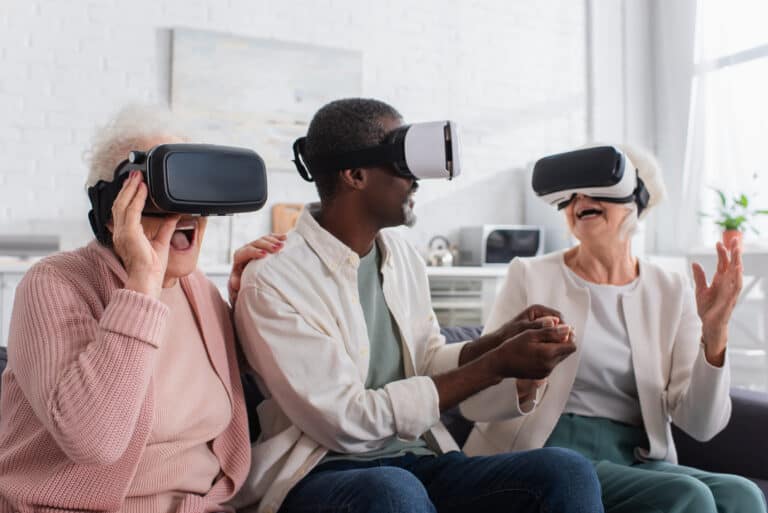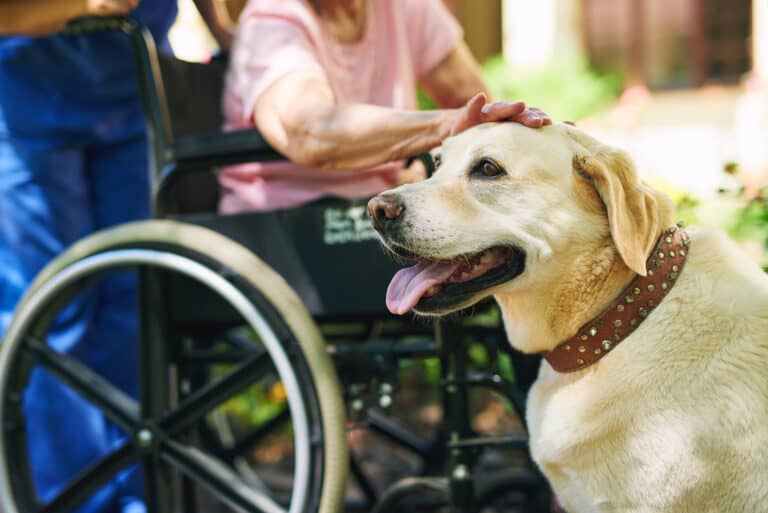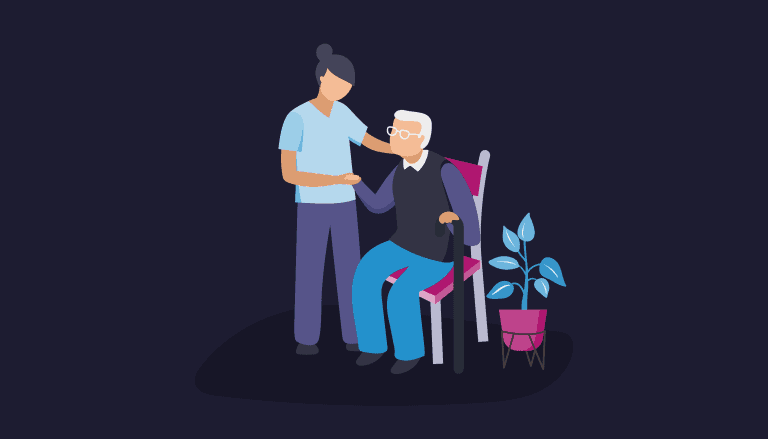4 stimulating care home activities that engage the senses
- Categories: Care Activities
Joe Webber
Share this article

Why do we need stimulation in care home activities?
Organising stimulating care home activities and incorporating them into resident care plans doesn’t only support wellbeing, it also keeps people connected to the world. When we live at home under our own independence, we crave stimuli to stop ourselves from becoming bored. We’re stimulated through our senses and turn to hobbies, holidays and unique experiences for enjoyment.
A stimulus can be anything which generates interest and enthusiasm. For example, concerts, museums or amusement parks. When people move into care, this need doesn’t go away. Interests may change and slower-paced activities might become more appealing, but mental and physical stimulation continues to play a key role in our development during our later years.
Mental stimulation helps our brains to stay active. When we’re encouraged to focus – either on completing tasks or participating in activities – we engage parts of the brain which are otherwise underused. Mental stimulation can be especially beneficial for individuals with degenerative conditions. There is evidence that stimulation can slow the rate of cognitive and functional decline.
Staff at care homes regularly look for new ideas to engage residents. Every few years, new trends emerge and more activities become available. Below, we’ve pulled together our top four picks for popular activities that effectively stimulate the senses and look at how they work.
Get absorbed in virtual reality – 2 senses
Virtual reality (VR) is still a relatively new concept in care. It’s been commercially accessible across different markets for decades but has established a solid position in the healthcare sector over the past several years. The full scope of benefits that VR can have for people in care is still being researched – but like the other activities on this list – it’s mainly used as a therapy tool, and as a way to offer unique, engaging experiences.
A fully immersive VR experience has the potential to stimulate the five basic human senses. However, the main two senses that are directly engaged by the headset are sight and sound. Scent, taste and touch have to be introduced separately to complement the experience, but can be done so at low costs. VR has the potential to ease stress and anxiety, evoke fun and meaningful memories, encourage exercise and transport people to real places they might not otherwise get to see.
VR could be a particularly practical activity for care settings with limited space, considering residents can interact with a virtual environment from the comfort of their chairs. It’s worth keeping in mind that because this is still an emerging industry, there are currently a small number of activity providers across the country that specialise in safe, person-centred VR experiences.
Spend an hour or two with animals – 4 senses
Animal-assisted therapy has become a very effective method of complementing traditional treatments and therapies. There’s a special comfort that only animals can provide – especially to people who grew up with pets. Animals easily engage four of our basic senses, through their different appearances, textures, smells and sounds. They can ignite old memories, promote exercise, relieve anxiety and provide a sense of independence.
Dogs are by far the most common four-legged visitors to care settings but in recent years large animals have become a trendy alternative. Ponies, donkeys and alpacas are popular with all ages and are known for their good temperaments and emotional intelligence. In many cases, they are still small enough that they can go indoors and even travel in lifts to reach residents that are unable to leave their rooms.
On the other side of the size spectrum, you can opt to go smaller and find an animal handler that specialises in reptiles, rodents and insects to add more variety to the experience. If hosting live animals isn’t possible in your setting, then you can introduce robotic pets as a form of therapy, which some care homes have done to support people living with dementia and reduce loneliness.

Create an indoor sensory space – 5 senses
If you care for people with dementia, autism, learning disabilities or other cognitive conditions, then you may benefit from creating a sensory room. Sensory rooms contain lots of interesting things to interact with and are usually suited to smaller groups or a single person.
Multi-sensory spaces offer people an emotional outlet, which is especially beneficial for individuals living with disabilities. They have yielded excellent results for residents who get frustrated due to their mental or physical capacities. Sensory rooms provide a focus, which improves moods by reducing agitation and aggression. Residents are also more likely to communicate with their carers in an engaging environment, helping to create better relationships and leading to more in-depth conversations to support their healthcare.
Sensory rooms can include just about anything which acts as stimuli. Popular items include interactive flooring, bubble displays, fish tanks, sound-activated light shows, mood lighting and large electronic devices like table tablets. But everyday items can be just as engaging, such as bubble wrap, a popcorn machine, bouncy balls, a digital fireplace display or dolls. It all depends on the preferences of the individuals that will be using the room.
Assembling a full sensory space can be costly as many items tend to be specialist. However, there’s no reason why items can’t be accumulated gradually. You can start small with cheaper items and occasionally add new items. This will help keep residents interested and give them something to look forward to. This is a real investment that can benefit residents all year round.
Visit a therapy garden (or grow your own!) – 5 senses
Outdoor activities might be better suited for sunnier seasons, so there are extra factors to consider when organising a group venture. Gardening is a favourite activity for many, due to its therapeutic effects and benefits to physical and mental wellbeing. Whether you’re tasked with arranging flower pots, planting bulbs or just watering the garden, this can be a relaxing and rewarding activity for all ages and abilities. If you want your residents to achieve certain goals through gardening, this is also known as horticultural therapy.
In the right conditions, gardening can engage all five basic senses. Just being in nature is stimulating in itself; with vibrant sights and curious sounds of wildlife. Gardening adds delicate textures and subtle smells of plants and earth. And finally, depending on what you grow, you can eventually taste the fruits of your labour.
Gardening can promote better physical health by improving mobility and strengthening muscles. It offers an opportunity to socialise with others in the group, reducing isolation and stress, while building new skills and creating a sense of achievement. There are dedicated therapy gardens located around the UK, usually operated by volunteers. If there isn’t one near you, this could be the year to start growing your own.
Using CareDocs
In the CareDocs digital care management system, the Group Events tool is used to create electronic records for group activities. Simply choose the event type, then tick the names of each resident that participated. Enter the event details and click ‘Save’ to store the note on the system. The note will also appear in each resident’s individual Daily Notes section.
CareDocs is a highly customisable system that allows users to create care plan sections and daily note events. Although we have a wide selection of templates in the system for you to choose from, you can easily add your own to ensure your data is recorded against accurate names.
Another tool that staff will find useful is Home Diary. It works similarly to Group Events but is used to keep a schedule of upcoming events that the organisation needs to be aware of. This can be used to record internal meetings or external visits for an activity.
To find out more about adopting the CareDocs system to help you record electronic notes and create person-centred digital care plans for your residents, email sales@caredocs.co.uk or click here to book a free face-to-face or remote demonstration.
Download a free sample care plan to see how CareDocs uses care assessment information to produce person-centred care plans for elderly residents, people with mental health conditions and people with learning disabilities.
Share this article
Author
Joe Webber
Search
Recent articles
- CareDocs Partners with the Professional Record Standards Body (PRSB) to Support Care Standards Fit for the Future of Digital Care January 30, 2024
- CareDocs Joins the Care Software Providers Association (CASPA), an Independent, Not for Profit Association, Representing Software in the Care Industry January 19, 2024
- CareDocs partners with Bristol Waste to tackle digital poverty January 10, 2024
Recent comments
- 1.2. Assess use of care plans in applying person-centered values - CIPD Writers on What is person centred care planning and why is it important?
- Call tracking tips for care home marketers - Chester Times on The importance of effective communication in care
- Why is effective communication important for positive relationships with individuals in care? - Building-Craft on The importance of effective communication in care











